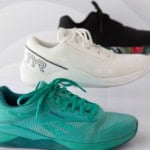
Omega-3 is one of the many key nutrients that is essential in sports nutrition because it can help with inflammation and soreness. Here are my recommendations for Omega-3 supplements in teen athletes as a registered dietitian nutritionist.

For more nutrition tips for teen athletes, check out our posts on Preventing Muscle Cramps in Teen Athletes and Is Prime Drink Healthy.
It is well known that exhaustive or unfamiliar exercise can lead to muscle fatigue, delayed-onset muscle soreness, and a decreased performance. Nutrition before and after exercise is essential to promote muscle repair and replenish fuel sources, giving athletes an advantage.
Unfortunately, many teens and their parents aren’t thinking about omega-3’s for sports performance. Here is what you need to know about this essential nutrient and your teen athlete.
What is Omega-3?
Omega-3 is an umbrella term used for essential fatty acids: ALA, EPA, and DHA. During digestion of fats our body breaks it down into fatty acids. Fatty acids have important functions in our body, like storing energy. ALA is an essential fatty acid, meaning we need to eat them in our diet because our body cannot synthesize it on its own. The body is able to convert ALA to EPA and DHA, but the process is slow and not very ineffective. This is why getting sources of all the omega-3’s from the diet is so critical
In a global survey it was found that the Americans had very low blood levels of omega-3 fatty acids. Regardless of athleticism level it is recommended everyone should be consuming 500 mg/day of omega-3 fatty acids a day.
Roles of Omega-3
Omega-3 has many critical functions in the human body. Some of the most well-known roles are (1):
- Cognitive Development
- Decreases Inflammation
- Eye Function
- Prevents Blood Clots
- Improves Attention and Responsiveness
- Improves Bone and Joint Health
While all of these roles are certainly important for teen athletes, the ability of omega-3’s to reduce inflammation is of particular interest in sports. Inflammation is a common by-product of a hard workout, practice, or game. We all know what it looks like to have too much inflammation (i.e. an injury with swelling) but even small amounts of inflammation could prevent optimal recovery.
Omega-3 and Sports
Sports nutrition focuses on two omega-3 fatty acids, DHA and EPA. This is because EPA and DHA is readily utilized by the body and can aid recovery. While ALA is not as heavily studied nor as absorbable as EPA and DHA.
The interest in omega-3 for athletes is because of the anti-inflammatory and antioxidant effect. These potential outcomes may improve tissue restoration and improve adaptation to the physical stress of training, from the muscle to even neural development. Specifically, EPA and DHA has shown favorable effects after workouts to reduce exercise triggered inflammation and muscle soreness. Also, during workouts omega-3 fatty acids improves blood flow, opening airways, and increasing flow of oxygen and nutrients into the muscle. These are all powerful reasons to focus on omega-3 intake for athletes. (2,3,4)
Benefits
Research has shown the potential benefits of omega-3 in sports as:
- Muscle metabolism and tissue recovery
- Improve functional performance
- Relieve inflammation
- Reduce sports related asthma
- Recovery from injury or traumatic brain injury
- Training adaptation
- Decrease muscle loss
Omega-3 Dosing for Athletes
Even though omega-3 has been found to be very beneficial in sports, the doses, concentration, and duration of omega-3 supplementation has not been specified. Although one study found that general guidelines for athletes should include about 1 to 2 grams per day of EPA and DHA, it is still unclear if supplementation should be pursued by all athletes.
Talk with your pediatrician or dietitian to confirm actual dosing of a supplement for your teen. A good starting place may be around 1000 mg of total omega-3’s a day, containing a mix of both EPA and DHA.

A safe approach is to always start with food first. Think about how often your athlete is consuming food sources of omega-3’s like fatty fish, nuts, seeds, and plant-based oils. The benefit to this approach is that not only is your athlete getting omega-3, but that food also provides a ton of nutrients and vitamins that a supplement alone may not. (5)
Tips for increasing omega-3:
- Swap to a DHA/EPA fortified milk.
- Swap to omega-3 fortified peanut butter (affiliate link) or margarine.
- Try granola bars that have chia, hemp, or flax seeds in them. This will provide a boost of omega-3.
- At home try cooking with flaxseed oil, cod liver oil, or canola oil.
- These oils have greater omega-3 content and are a good oil alternative.
- Swap out meat for seafood 1-2 times a week (salmon, mackerel, sardines, tuna, and other seafood).
- Recommend 6-8 ounces of fish per week or 3-4 ounces a serving.
- When shopping choose grass-fed beef and omega-3 fortified eggs. (6,7,8)
- These are more expensive options, and are not the only way to increase omega-3 consumption.
- Eat 1 oz of nuts a day like almonds or walnuts.
- Top yogurt, cereals, smoothies, and salads with 1-2 tablespoon of chia seeds, ground flaxseed, or walnuts.

Omega-3 Tips
If an omega-3 supplement is best for you or your athlete here are some tips:
- Take supplement with food or close to mealtime to promote optimal absorption of omega-3 fatty acids.
- Remember that more is not better. Stick to recommended guidelines or health practitioner recommendations for the amount of daily omega-3 mg needed.
- Taking the supplement with a high fat food may boost absorption, such as avocado, peanut butter, and nuts.
- Check for freshness by smelling for rancidity, refrigerate to keep fresh.
- If your athlete experiences unpleasant burping after taking their supplement, try storing it in the freezer and taking it frozen. You can also buy supplements that reduce this side effect.
- When shopping look for:
- The dose amount (mg)
- Amount of EPA and DHA: read ingredients
- Form of omega-3: fish oil, krill oil, algae, etc.
- USP, NSF, Informed Sport or Informed Choice certifications on supplements, which are governing bodies that certify for purity.
Takeaways
Omega-3 is important for overall health and may particularly be beneficial for athletes. Research has shown that omega-3 may positively impact athletic performance by relieving muscle soreness and decreasing inflammation. To get the full benefits of omega-3 athletes should first eat foods like fatty fish, plant-based oils, nuts, seeds, and algae. If your athlete does not eat these food regularly, then you might consider a supplement.
Omega-3 supplements can be found over the counters in the medicine section at your local grocery store. You can also purchase it online through reputable companies like Nordic Naturals and Brain Armor. The recommended amount of omega-3 for the American diet is 500 mg per day, but in sports nutrition research there is no set dose amount. A dose of around 1000 mg may be a good starting place for a supplement, but it is important to first consult your pediatrician or dietitian.
WRITTEN BY DIETETIC INTERN SIGOURNEY MCGOVERN AND COACH JENNA BRADDOCK.
References
- https://ods.od.nih.gov/factsheets/Omega3FattyAcids-HealthProfessional/
- GLIGOR Șerban, GLIGOR R. The potential role of omega-3 fatty acids supplements in increasing athletic performance. Timisoara Physical Education & Rehabilitation Journal. 2016;9(16):25-34.
- Jakše B. Potential Benefits of Consuming Omega-3 Fatty Acids for Artistic Gymnasts. Možne Koristi Uživanja Omega 3 Maščobnih Kislin Pri Orodni Telovadbi. Science of Gymnastics Journal. 2017;9(2):127-152.
- Atashak S, Sharafi H, Azarbayjani MA, Stannard SR, Goli MA, Haghighi MM. Effect of Omega-3 Supplementation on the Blood Levels of Oxidative Stress, Muscle Damage and Inflammation Markers After Acute Resistance Exercise in Young Athletes. Kinesiology. 2013;45(1):22-26.
- https://www.ncbi.nlm.nih.gov/pmc/articles/PMC2846864/https://www.ncbi.nlm.nih.gov/pubmed/21673178https://www.ncbi.nlm.nih.gov/pmc/articles/PMC5434201/
- https://www.ncbi.nlm.nih.gov/pmc/articles/PMC2846864/
- https://www.ncbi.nlm.nih.gov/pubmed/21673178
- https://www.ncbi.nlm.nih.gov/pmc/articles/PMC5434201/
















